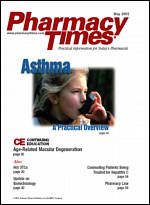Publication
Article
Pharmacy Times
Asthma: A Practical Overview
Author(s):
Asthma is a chronic lung condition that affects millions of Americans. The prevalence of asthma continues to increase. The 1997 National Health Interview Survey reported that nearly 26 million Americans had been diagnosed with the disease. Children, women, and African Americans are most commonly affected.
Asthma-related symptoms cause nearly 14 million outpatient visits, 2 million Emergency Department visits, and >400,000 hospitalizations annually. Asthma accounts for $8 million in direct health care costs. It also accounts for $4.6 billion in lost productivity due to 3 million lost workdays and 10 million lost school days annually.1-3 According to the update of the National Heart, Lung and Blood Institute?s National Asthma Education and
Prevention Program guidelines (NAEPP II), asthma is a chronic inflammatory disorder of the airways characterized by recurrent episodes of wheezing, breathlessness, chest tightness, and coughing, particularly at night or in the early morning. These episodes are usually associated with widespread but variable airflow obstruction that is often reversible either spontaneously or with treatment.
This working definition provides many important concepts. The first is that chronic inflammation causes asthmatic symptoms. The discovery of the role of inflammation in asthma has significantly altered the goal of research. Now research is aimed at finding means to control the mediators of inflammation. Early control of these mediators may prevent permanent lung damage.
The second key concept is the reversibility of airflow obstruction. The reversibility of symptoms differentiates asthma from other disorders, such as chronic obstructive pulmonary disease. Because symptoms are reversible, rescue agents are now aimed at immediate relief, and long-acting anti-inflammatory agents control chronic inflammation.
Classification of Severity
The NAEPP II established classifications for the severity of asthma.4 These classifications are necessary to guide therapy and to assess progression of symptoms. Assessment of severity includes assessing frequency of symptoms, severity of exacerbations, effect on activity, and predictability of peak flow rates. The categories are mild intermittent, mild persistent, moderate persistent, and severe persistent.
Patients with mild intermittent severity are asymptomatic and can maintain a normal level of activity between their brief exacerbations. These patients have symptoms 2 times a week and nocturnal symptoms 2 times per month. Their lung function is normal between exacerbations, with little variability in peak flow readings that remain 80% of the predicted volume.
Mild persistent asthma involves developing symptoms >2 times a week but <1 time daily. These patients have nocturnal symptoms >2 times a month. Their physical activity may be limited during exacerbations. Peak flow readings may have a variability of 20% to 30%.
Patients with daily symptoms or use of a short-acting beta-agonist and nocturnal symptoms each week are classified as having moderate persistent asthma. Physical activity is affected during exacerbations that may last days or occur >2 times a week. Peak flow readings are typically between 60% and 80% of predicted or have a variability of >30%.
Severe persistent asthma greatly affects the patient?s life on account of continuous symptoms and frequent exacerbations. Physical activity is limited due to peak flow readings of 60% of predicted with variability of >30%.
TreatmentThe treatment of asthma has greatly advanced in the past 10 years. New oral agents, along with new inhalation formulations, have progressed treatment since the days of just theophylline and albuterol. The new medications and formulations are allowing patients to meet the goals outlined in NAEPP II (Table).
Delivery Devices
Delivery devices now include metered-dose inhalers (MDIs), breath-actuated inhalers, nebulizers, and dry-powder inhalers. MDIs remain the most popular delivery device because of their ease of use, efficacy, and portability. They consist of a pressurized canister with a valve that dispenses a measured amount of medication when pressed. MDIs are now available that contain hydrofluoroalkane (HFA) rather than chlorofluorocarbon (CFC).
Breath-actuated MDIs provide medication only under the pressure of inspiration. This option is helpful for patients who are unable to coordinate inspiration with actuation of a conventional MDI. Unfortunately, the breath-actuated system does not allow for the use of a spacer.
Nebulizers?jet nebulizers and ultrasonic ones?aerosolize a liquid solution for inhalation. Jet nebulizers use oxygen or pressurized air to draw the aerosolized solution through a tube to which a mouthpiece or mask is attached. Ultrasonic nebulizers aerosolize the solution through vibration. They are not effective for micronized solutions. Also, nebulizers are not pocket-sized like MDIs.
The newest formulations are the dry, micronized powders. These powders are inhaled directly into the lungs. Some products are self-contained with medication, whereas the others need to have medication added for each dose. The advantages of dry-powder inhalers are that they are breath-actuated and require minimal coordination. They require a high inspiratory flow rate, however.
Medications
Although rescue agents, such as albuterol, are typically the first medications used to treat a newly diagnosed patient, long-term control agents are now routinely used to control symptoms and to modify the inflammatory process. These agents include long-acting beta-agonists, leukotriene inhibitors, and corticosteroids.
The biggest advance in rescue therapy is the availability of levalbuterol. Levalbuterol is the (R)-enantiomer of albuterol. It is dosed at 0.63 or 1.25 mg 3 times daily. The 0.63-mg dose is equipotent to 2.5 mg of racemic albuterol.
A pair of other beta-agonists have reached the market, both of which are long-acting agents. The first, called salmeterol, is used twice daily for maintenance therapy. Because it lacks anti-inflammatory properties, it is not used in place of a corticosteroid. Since it has an onset of 15 to 30 minutes, it is not an appropriate substitute for short-acting beta-agonists and therefore should never be used for rescue.
The second long-acting beta-agonist to reach the market is formoterol. It is available as a dry-powder capsule for oral inhalation, and it has a shorter onset of action than salmeterol. Formoterol is indicated for maintenance treatment in adults and children over 5 years old and for acute prevention of exercise-induced bron-chospasm in adults and children over 12 years old. Like salmeterol, it is dosed twice daily.
Many inhaled corticosteroids are available on the market, but the newest addition is budesonide inhalation suspension. It is the only nebulized steroid available. Budesonide is indicated for maintenance treatment in children and adults. The recommended starting dose is 0.5 mg 1 to 2 times daily, with a maximum dose of 1 mg daily. Common side effects include respiratory infection, rhinitis, cough, otitis media, diarrhea, rash, and moniliasis. Budesonide is metabolized by cytochrome P-450 3A and therefore may interact with ketoconazole and cimetidine.
Montelukast is an oral leukotriene receptor antagonist, indicated for the prophylaxis and chronic treatment of adults and children over 2 years old. Side effects include fatigue, dyspepsia, nausea, headache, sinusitis, cough, rash, and increased liver enzymes. Montelukast is dosed at 10 mg daily to patients over 15 years, 5 mg to children 6 to 14 years, and 4 mg to children 2 to 5 years.
Other new releases on the market are improvements on previously available agents. These include the following:
? Beclomethasone propionate HFA?the first CFC-free corticosteroid MDI
? Fluticasone propionate/salmeterol inhalation powder?a combination product containing dry powder for use in a breath-actuated device
Patient Education
The NAEPP II guidelines stress the importance of patient education in the prevention of exacerbations. Pharmacists can reiterate many important facts to the patient at routine medication fills. Continued education will motivate patients to comply with prescribed therapy and monitoring measures. Involving the family in this education will increase the patient?s support system and encourage participation in the patient?s care. Counseling always should encourage a 2-way discussion and should be at a level understandable to the patient based on education, age, and native language. Plans should be as simple to follow as possible.
Patients should understand the basic mechanisms of inflammation and bronchoconstriction. Most patients do not need to know about mast cells and T lymphocytes. An understanding that inflammation causes their symptoms?as well as a realization of what their personal triggers and symptoms are?helps patients understand why they are using certain medications. A lack of understanding often creates misconceptions and leads to noncompliance.
Reiterating the goals of therapy, as outlined in the Table, will remind patients that their health care providers are trying to improve their quality of life. All patients want to experience less frequent symptoms and to continue activities of daily living.
Patients with moderate or severe persistent asthma or a history of severe exacerbations should use a peak flow meter. Because patients may visit the pharmacy more often than the physician?s office, the pharmacist can assist patients by reviewing their technique and their peak flow readings.
Pharmacists are the experts on medications and therefore should always remind patients of the role for each medication (rescue vs prevention), the administration techniques, care for inhalers, and when to seek medical attention. The majority of asthma-related hospital admissions are preventable. With the correct pharmacotherapy and continued patient education, many exacerbations can be circumvented.
TableGoals for Asthma Management According to NAEPP II
? Maintain normal activity levels, including exercise and other physical activity
? Maintain pulmonary function
? Minimize and prevent symptoms, including cough or breathlessness
? Prevent recurrent exacerbations and need for emergency care or hospitalization
? Provide optimal pharmacotherapy with minimal adverse effects
? Meet patient?s expectations of care
NAEPP = National Asthma Education and Prevention Program.Source: National Heart, Lung and Blood Institute. Expert Panel Report 2: Guidelines for Diagnosis and Management of Asthma. Bethesda, MD: National Institutes of Health; July 1997.
For a list of references, send a stamped, self-addressed envelope to: References Department, Attn. D. Campagnola, Pharmacy Times, 241 Forsgate Drive, Jamesburg, NJ 08831; or send an e-mail request to: [email protected].







